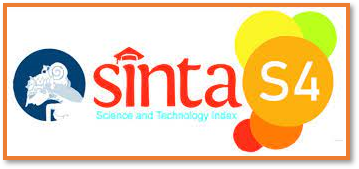Review: Potency of Borneo Endemic and Typical Plants as Anti-Cancer Medicines
Abstract
The Island of Borneo (also known as Kalimantan), Indonesia has extensive forests overgrown with various plants. Some of them have been believed for generations and empirically have efficacy as traditional medicines. It is estimated that more than 200 medicinal plants are growing in the forests of Borneo Island. Some of them had been studied to have a number of secondary metabolites that act as anticancer, such as Bawang Dayak/Bawang Tiwai (Dayak/Tiwai Onion), Tahongai, Tanaman Sarang Semut (Ant Nest Plant), Batang Kuning (Yellow Stem)/Akar Kuning (Yellow Root), and Pasak Bumi/Tongkat Ali. Meanwhile, some of them still need to be investigated further regarding the secondary metabolites of their plant parts and their properties as herbal medicines, especially as anti-cancer, such as Sengkubak, Kayu Bajakah (Bajakah Wood), and Jahe Balikpapan (Balikpapan Ginger).
Keyword: Anti-Cancer, Secondary Metabolites, Herbal Medicines, Borneo Endemic Plants
Full Text:
PDFReferences
Sung H, Ferlay J, Soerjomataram I, Siegel RL, Laversanne M, Soerjomataram I, et al. Global Cancer Statistics 2020: GLOBOCAN Estimates of Incidence and Mortality Worldwide for 36 Cancers in 185 Countries. CA Cancer J Clin. 2021; 71: 209 – 249. https://doi.org/10.3322/caac.21660.
Arruebo M, Vilaboa N, Saez-Gutierrez B, Lambea J, Tres A, Valladares M, et al. Assessment of The Evolution of Cancer Treatment Therapies. Cancers. 2011; 3(3): 3279 – 3330. https://doi.org/10.3390/cancers3033279.
Shabani A. A Review of Anticancer Properties of Herbal Medicines. J Pharma Care Health Sys. 2016; 3(2): 1 – 4. http://dx.doi.org/10.4172/2376-0419.1000160.
Sholikhah EN. Indonesian Medicinal Plants as Sources of Secondary Metabolites for Pharmaceutical Industry. J Med Sci. 2016 Oct; 48(4): 226 – 239. https://doi.org/10.19106/JMedSci004804201606.
Dengen N, Budiman E, Widians JA, Wati M, Hairah U, Ugiarto M. Biodiversity Information System: Tropical Rainforest Borneo and Traditional Knowledge Ethnic of Dayak. Journal of Telecommunication, Electronic and Computer Engineering. 2018; 10(1-9): 59 – 64. http://dx.doi.org/10.1166/asl.2018.12321.
Borneo Biodiversity Information System (BBIS). Medical Plant. Available at: https://www.borneodiversity.org/index/medicinal.
Widians JA, Wati M, Tejawati A, Budiman E. Biodiversity Information System for Medical Plants Data Tropical Rainforest Borneo. International Journal of Engineering & Technology. 2018; 7(4.44): 31 – 36. http://dx.doi.org/10.14419/ijet.v7i4.44.26858.
Jain C, Khatana S, Vijayergia R. Bioactivity of Secondary Metabolites of Various Plants. IJPSR. 2019; 10(2): 494 – 504. http://dx.doi.org/10.13040/IJPSR.0975-8232.10(2).494-04.
Guerriero G, Berni R, Muños-Sanchez JA, Apone F, Abdel-Salam EM, Qahtan AA, et al. Production of Plant Secondary Metabolites: Examples, Tips and Suggestions for Biotechnologist. Genes (Basel). 2018 Jun; 9(6): 309. https://doi.org/10.3390/genes9060309.
Seca AML, Pinto DCGA. Plant Secondary Metabolites as Anticancer Agents: Successes in Clinical Trials and Therapeutic Application. Int J Mol Sci. 2018 Jan; 19(1): 263. https://doi.org/10.3390/ijms19010263.
Shin S-A, Moon SY, Kim W-Y, Paek S-M, Park HH, Lee CS. Structure-Based Classification and Anti-Cancer Effects of Plant Metabolites. Int J Mol Sci. 2018 Sep; 19(9): 2651. https://doi.org/10.3390/ijms19092651.
Goel S, Parihar PS, Meshram V. Plant-Derived Quinones as a Source of Antibacterial and Anticancer Agents. In: Singh J., Meshram V., Gupta M. (eds) Bioactive Natural products in Drug Discovery. Springer, Singapore. 2020. http://dx.doi.org/10.1007/978-981-15-1394-7_6.
Birudu RB and Naik MJ. Anticancer Properties of Secondary Metabolites of Medicinal Plants in Carcinoma. British Biomedical Buletin (BBB). 2014; 2(4): 662 – 668.
Wiendi NMA, Maulida N, Krisantini K. Biology and bulb production of Eleutherine bulbosa (Iridaceae), a native species from Borneo, Indonesia. Ornam. Hortic. 2021; 27(2): 232 – 237. https://doi.org/10.1590/2447-536X.v27i2.2269.
Insanu M, Kusmardiyani S, Hartati R. Recent Studies on Phytochemicals and Pharmacological Effects of Eleutherine Americana Merr. Procedia Chemistry. 2014; 13: 221 – 228. http://dx.doi.org/10.1016/j.proche.2014.12.032.
Kuntorini EM, Dewi M, Misrina. Anatomical Structure and Antioxidant Activity of Red Bulb Plant (Eleutherine americana) on Different Plant Age. Biodiversitas Journal of Biological Diversity. May 2016; 17(1): 229 – 233. http://dx.doi.org/10.13057/biodiv/d170133.
Shi P, Du W, Wang Y, Teng X, Chen X, Ye L. Total Phenolic, Flavonoid Content, and Antioxidant Activity of Bulbs, Leaves, and Flowers made from Eleutherine bulbosa (Mill.) Urb. Food Sci Nutr. 2018 Dec 21; 7(1): 148 – 154. https://doi.org/10.1002/fsn3.834.
Mutiah R, Minggarwati TS, Kristanti RA, Susanti E. Compound Identification and Anticancer Activity of Ethyl Acetate Fraction from Bawang Sabrang (Eleutherine palmifolia (L.) Merr.) on HeLa Cervical Cancer Cell Line. Indones. J. Cancer Chemoprevent. 2019; 10(3): 131 – 139. http://dx.doi.org/10.14499/indonesianjcanchemoprev10iss3pp131-139.
Saibu M, Sagar S, Green I, Ameer F, Meyer M. Evaluating the Cytotoxic Effects of Novel Quinone Compounds. Anticancer Research August. 2014; 34(8): 4077 – 4086. https://pubmed.ncbi.nlm.nih.gov/25075032/.
Xu J, Qiu F, Duan W, Qu G, Wang N, Yao X. New Bioactive Constituents from Eleutherine Americana. Front. Chem. China. 2006; 1: 320-323. https://doi.org/10.1007/s11458-006-0032-7.
Amelia T, Pratiwi D, Romsiah, Tjahjono DH. In Silico Study of The Component of Eleutherine americana Merr. on Human Estrogen Reseptor Alpha as Potential Anti-Breast Cancer. 3rd International Conference on Computation for Science and Technology (ICCST-3). Atlantis Press. 2015: 1 – 6. https://doi.org/10.2991/iccst-15.2015.2.
Tayeb R, Wahyudin E, Alam G, Pakki E, Lukman L. Preclinical Study: Hepatoprotective Effects of “Paliasa Tea Bag” on Paracetamol-Induced Liver Damage in Rats. The 2nd International Congress of Naturopathic Medicine. Paris. 2014.
Solihah I, Mardiyanto, Fertilita S, Herlina, Charmila O. Standardization of Ethanolic Extract of Tahongai Leaves (Kleinhovia hospita L.). Sci. Technol. Indonesia. (2018); 3: 14 – 18. https://doi.org/10.26554/sti.2018.3.1.14-18.
Arung ET, Kusuma IW, Purwatiningsih S, Roh SS, Yang CH, Jeon S, et al. Antioxidant Activity and Cytotoxicity of the Traditional Indonesian Medicine Tahongai (Kleinhovia hospita L.) Extract. J Acupunct Meridian Stud. 2009 Dec; 2(4): 306 – 308. https://doi.org/10.1016/s2005-2901(09)60073-x.
Arung ET, Kusuma IW, Kim YU, Shimizu K, Kondo R. Antioxidative compounds from leaves of Tahongai (Klienhovia hospita). Journal of Wood Science. 2012; 58: 77 – 80. https://doi.org/10.1007/s10086-011-1217-7.
Imran, Noor A, Soekamto NH, Megawati, Kadir LA. Bioaktivitas Metabolit Sekunder Batang Kayu Paliasa (Kleinhovia hospital Linn) dengan Uji BST (Brine Shrimp Lethality Test) dan Daya Hambatnya Pada Sel Leukimia P-388 Bioaktivitas Metabolit Sekunder Batang Kayu Paliasa (Kleinhovia hospital Linn) dengan Uji BST (Brine Shrimp Lethality Test) dan Daya Hambatnya Pada Sel Leukimia P-388. BioWallacea Jurnal Penelitian Biologi (Journal of Biological Research). November 2020; 7(2): 1134 – 1140. http://dx.doi.org/10.33772/biowallacea.v7i2.14883.
Djabir YY, Arsyad MA, Sartini S, Lallo S. Potential Roles of Kleinhovia hospita L. Leaf Extract in Reducing Doxorubicin Acute Hepatic, Cardiac and Renal Toxicities in Rats. Pharmacognosy Res. 2017 Apr-Jun; 9(2): 168 – 173. https://dx.doi.org/10.4103%2Fpr.pr_129_16.
Hamsar MN, Mizaton HH. Potential of Ant-Nest Plants as An Alternative Cancer Treatment. Journal of Pharmacy Research. 2012 June; 5(6): 3063 – 3066.
Prachayasittikul S, Buraparuangsang P, Worachartcheewan A, Ayudhya CIN, Ruchirawat S, Prachayasittikul V. Antimicrobial and Antioxidative Activities of Bioactive Constituents from Hydnophytum formicarum Jack. Molecules. 2008 Apr; 13(4): 904 – 921. https://dx.doi.org/10.3390%2Fmolecules13040904.
Abdullah H, Pihie AHL, Hohmann J, Molnar J. A Natural Compound from Hydnophytum formicarium Induces Apoptosis of MCF-7 Cells via Up-Regulation of Bax. Cancer Cell International. 2010; 10(14): 1 – 6. https://doi.org/10.1186/1475-2867-10-14.
Darwis D, Hertiani T, Samito E. The Effects of Hydnophytum formicarum Ethanolic Extract towards Lymphocyte, Vero and T47d Cells Proliferation In Vitro. J App Pharm Sci. 2014; 4(6): 103 – 109. https://dx.doi.org/10.7324/JAPS.2014.40616.
Sababathy M, Kassim MNI, Ahmad AS, Amir H, Syamsumir DF, Andriani Y. Phytochemicals Study, Antioxidant and Cytotoxicity Properties of Hydnophytum formicarum (Kepala beruk) Leaves against HepG2 and HeLa Cell Lines. Orient. J. Chem. 2020; 36(3): 425 – 433. http://dx.doi.org/10.13005/ojc/360310.
Engida AM, Kasim NS, Tsigie YA, Ismadji S, Huynh LH, and Ju Y-H. Extraction, Identification and Quantitative HPLC Analysis of Flavonoids from Sarang Semut (Myrmecodia pendan). Industrial Crops and Products. 2013; 392 – 396. https://doi.org/10.1016/j.indcrop.2012.04.043.
Sudiono J, Oka CT, Trisfilha P. The Scientific Base of Myrmecodia pendans as Herbal Remedies. BJMMR. 2015; 8(3): 230 – 237. https://doi.org/10.9734/BJMMR/2015/17465.
Achmad MH, Horax S, Ramadhany S, Rieuwpassa IE, Sari M, Handayani H, et al. Anti-Cancer and Anti-Proliferation Activity of Ethyl Asetat Extract from Ant Nest (Myrmecodia pendans) in Burkitt’s Lymphoma Cancer Cells. Pesqui. Bras. Odontopediatria Clín. Integr. 2019; 19: e4325. https://doi.org/10.4034/PBOCI.2019.191.29.
Irfanita N, Eddie S, Aziz NA, Ichwan SJA, Lestari W. Preliminary Investigations of Anti-Cancer Properties of Myrmecodia Pendens on Human Oral Cancer HSC-3 Cell Lines. Materials Today: Proceedings. 2019; 16(4): 2197 – 2203. https://doi.org/10.1016/j.matpr.2019.06.110.
Supriatno. Antitumor activity of Papua’s Myrmecodia pendans in Human Oral Tongue Squamous Cell Carcinoma Cell Line through Induction of Cyclin-Dependent Kinase Inhibitor p27Kip1 and Suppression of Cyclin E. J Cancer Res Ther. 2014; 2(3): 48 – 53. http://dx.doi.org/10.14312/2052-4994.2014-7.
Bashari MH, Hidayat S, Ruswandi YAR, Putri T, Qomarilla N, Dwiwina RG, et al. The n-Hexane Fraction of Myrmecodia pendans Inhibits Cell Survical and Proliferation in Colon Cancer Cell Line. Int J Pharm Pharm Sci. 2018; 10(1): 108 – 112. https://doi.org/10.22159/ijpps.2018v10i1.21882.
Swandi YAR, Hidayat S, Huda F, Putri T, Qomarilla N, Kurnia D, et al. The n-Hexane Fraction of Myrmecodia pendans Suppresses Survival and Proliferation in Colon Cancer Cells. Annals of Oncology. 2017 November; 28(10). https://doi.org/10.1093/annonc/mdx652.014.
Fatmawati D, Puspitasari PK, Yusuf I. Cytotoxic Effect of Ethanolic Extract of Sarang Semut (Myrmecodia pendens) on HeLa Cervix Cancer Cell Line In Vitro Experimental Study. Sains Medika. 2011; 3(2): 112 – 120. http://dx.doi.org/10.26532/sainsmed.v3i2.393.
Soeksmanto A, Subroto MA, Wijaya H, Simanjuntak P. Anticancer Activity Test for Extracts of Sarang Semut Plant (Myrmecodya pendens) to HeLa and MCM-B2 Cells. Pakistan Journal of Biological Sciences, 2010; 13: 148 – 151. https://doi.org/10.3923/pjbs.2010.148.151.
Ju A, Cho Y-C, Kim BR, Lee S, Le HTT, Vuong HL, Cho S. Anticancer Effects of Methanol Extract of Myrmecodia platytyrea Becc. Leaves against human hepatocellular carcinoma cells via inhibition of ERK and STAT3 signaling pathways. Int J Oncol. 2018 Jan; 52(1): 201 – 210. https://doi.org/10.3892/ijo.2017.4178.
Andriani Y, Mohamad H, Kassim MNI, Rosnan ND, Syamsumir DF, Saidin J, et al. Evaluation on Hydnophytum formicarum Tuber from Setiu Wetland (Malaysia) and Muara Rupit (Indonesia) for Antibacterial and Antioxidant activities, and anti-cancer Potency against MCF-7 and HeLa Cells. Journal of Applied Pharmaceutical Science. 2017; 7(09): 030 – 037. https://dx.doi.org/10.7324/JAPS.2017.70904.
Keawpradub N, Dej-adisai S, Yuenyongsawad S. Antioxidant and Cytotoxic Activities of Thai Medicinal Plants Named Khaminkhruea: Arcangelisia flava, Coscinium blumeanum and Fibraurea tinctoria. Songklanakarin J. Sci. Technol. 2005; 27(Suppl. 2): 455 – 467.
Sulistiarini R, Soemardji AA, Elfahmi, Iwo MI. Pharmacological Activities of Three Kinds “Kayu kuning”: Arcangelisia flava, Fibraurea tinctoria and Coscinium fenestratum – an Short Review. J. Trop. Pharm. Chem. 2020; 5(2): 150 – 156. https://doi.org/10.25026/jtpc.v5i2.258.
Potikanond S, Chiranthanut N, Khonsung P, Teekachunhatean S. Cytotoxic Effect of Coscinium fenestratum on Human Head and Neck Cancer Cell Line (HN31). Evidence-Based Complementary and Alternative Medicine. Hindawi Publishing Corporation. 2015: 1 – 8. https://doi.org/10.1155/2015/701939.
Sandeep D, Ramasamy S, Krishnan R, Karunagaran D, Al Suhaibani E, Nair CKK. Evaluation of Cytotoxic and Anti-Tumor Activities of Coscinium fenestratum Extract. AJPCT. 2014; 2(12): 1346 – 1360.
Rojsanga P, Sukhthankar M, Krisanapun C, Gritsanapan W, Lawson DB, Baek SJ. In Vitro Anti-Proliferative Activity of Alcoholic Stem Extract of Coscinium fenestratum in Human Colorectal Cancer Cells. Experimental and Therapeutic Medicine. 2010; 1: 181 – 186. https://doi.org/10.3892/etm_00000029.
Mutiah R, Kirana FO, Annisa R, Rahmawati A, Sandra F. Extract of Yellow Root (Arcangelisia Flava (L.) Merr.) from Several Regions in Kalimantan: Alkaloid Content and Cytotoxicity towards WiDr Colorectal Cancer Cells. Indones. J. Cancer Chemoprevent. 2020; 11(2): 84 – 89. http://dx.doi.org/10.14499/indonesianjcanchemoprev11iss2pp84-89.
Tungpradit R, Sinchaikul S, Phutrakul S, Wongkham W, Chen S-T. Anti-Cancer Compound Screening and Isolation: Coscinium fenestratum, Tinospora crispa and Tinospora cordifolia. Chiang Mai J. Sci. 2010; 37(3): 476 – 488. https://epg.science.cmu.ac.th/ejournal/dl.php?journal_id=24.
Barbosa-Filho JM, Leitao da-Cunha EV, Gray AI. Alkaloids of Menispermaceae. The Alkaloids: Chemistry and Biology. Academic Press. 2000: 1 – 190. https://doi.org/10.1016/S0099-9598(00)54002-4.
Pratama MRF, Mulyani E, Suratno. Molecular Docking Study of Akar Kuning (Arcangelisia flava) Secondary Metabolites as Src Inhibitor. Indones. J. Cancer Chemoprevent. 2019; 10(3): 122 – 130. http://dx.doi.org/10.14499/indonesianjcanchemoprev10iss3pp122-130.
Pratama MRF. Akar Kuning (Arcangelisia flava) as EFGR Inhibitor: In Silico Study. Farmagazine. 2016; 3(1): 6 – 16. https://ssrn.com/abstract=3023163.
Puspitasari E, Pangaribowo DA, Utami Y, Isparnaning IY. Arcangelisia flava Leaves Ethanolic Extract Supresses Cancer Cell Lines via Non Apoptotic Pathway. UNEJ e-Proceeding. 2017. 83 – 86. ISSN 2686-0783. Accessed 25 Sep. 2021. Available at: https://jurnal.unej.ac.id/index.php/prosiding/article/view/3898.
Hidayati S, Zuhud EAM, Adiyaksa IK, Al Manar P. Review: The ethnotaxonomy and bioecology of pasak bumi (Eurycoma longifolia Jack.). Journal of Natural Resources and Environmental Management). 2021; 11(2): 177 – 178. https://doi.org/10.29244/jpsl.11.2.177-178.
Bhat R and Karim AA. Tongkat Ali (Eurycoma longifolia Jack): A Review on Its Ethnobotany and Pharmacological Importance. Fitoterapia. 2010: 81; 669 – 679. https://doi.org/10.1016/j.fitote.2010.04.006.
Khanam Z, Wen CS, Bhat IUH. Phytochemical screening and antimicrobial activity of root and stem extracts of wild Eurycoma longifolia Jack (Tongkat Ali). Journal of King Saud University – Science. 2015; 27(1): 23 – 30. https://doi.org/10.1016/j.jksus.2014.04.006.
Fiaschetti G, Grotzer MA, Shalaby T, Castelletti D, Arcaro A. Quassinoids: From traditional drugs to new cancer therapeutics. Curr Med Chem. 2011; 18(3): 316 – 328. https://doi.org/10.2174/092986711794839205.
Tung NH, Uto T, Hai NT, Li G, Shoyama Y. Quassinoids from the Root of Eurycoma longifolia and Their Antiproliferative Activity on Human Cancer Cell Lines. Pharmacogn Mag. 2017 Jul-Sep; 13(51): 459 – 462. https://doi.org/10.4103/pm.pm_353_16.
Supartini, Maharani R, Fernandes A, Waluyo TK. Herbal Tea of Yellow Bitter Charm (Eurycoma longifolia Jack.) Leaves and Its Potential Analysis for Commercial Herbs Drink. IOP Conf. Ser.: Earth Environ. Sci. 2020; 415: 012022. http://dx.doi.org/10.1088/1755-1315/415/1/012022.
Tee TT and Azimahtol HLP. Induction of Apoptosis by Eurycoma longifolia Jack Extracts. Anticancer Res. 2005 May-Jun; 25(3B): 2205-13. PMID: 16158965. http://www.ncbi.nlm.nih.gov/pubmed/16158965.
Zakariya Y, Rahmat A, Pihie AHL, Abdullah NR, Houghton PJ. Eurycomanone Induce Apoptosis in HepG2 Cells via Up-Regulation of p53. Cancer Cell Int. 2009; 9: 16. https://doi.org/10.1186/1475-2867-9-16.
Wong PF, Cheong WF, Shu MH, The CH, Chan KL, AbuBakar S. Eurycomanone Suppresses Expression of Lung Cancer Cell Tumor Markers, Prohibitin, Annexin 1 and Endoplasmic Reticulum Protein 28. Phytomedicine. 2012. 19: 138 – 144. https://doi.org/10.1016/j.phymed.2011.07.001.
Al Salahi, Ji D, Majid AMSA, Kit-Lam C, Abdullah WZ, Zaki A, et al. Anti-Tumor Activity of Eurycoma longifolia Root Extracts against K-562 Cell Line: In Vitro and In Vivo Study. PLoS One. 2014; 9(1): e83818. https://doi.org/10.1371/journal.pone.0083818.
Hajjouli S, Chateauvieux S, Teiten M-H, Orlikova B, Schumacher M, Dicato M, et al. Eurycomanone and Eurycomanol from Eurycoma longifolia Jack as Regulators of Signaling Pathways Involved in Proliferation, Cell Death and Inflammation. Molecules. 2014; 19(9): 14649 – 14666. https://doi.org/10.3390/molecules190914649.
Tong KL, Chan KL, Abu Bakar S, Low BS, Ma HQ, Wong PF. The In Vitro and In Vivo Anti-Cancer Activities of a Standardized Quassinoids Composition from Eurycoma longifolia on LNCaP Human Prostate Cancer Cells. PLoS ONE. 2015; 10(3): e0121752. https://doi.org/10.1371/journal.pone.0121752.
Moses LB, Abu Bakar MF, Mamat H, Aziz ZA. Unfermented Freeze-Dried Leaf Extract of Tongkat Ali (Eurycoma longifolia Jack.) Induced Cytotoxicity and Apoptosis in MDA-MB-231 and MCF-7 Breast Cancer Cell Lines. Evid Based Complement Alternat Med. 2021 Jan 30; 2021: 8811236. https://doi.org/10.1155/2021/8811236.
Setyiasi m, Ardiningsih P, Nofiani R. Analisis Organoleptik Produk Bubuk Penyedap Rasa Alami dari Ekstrak Daun Sansakng (Pycnarrhena cauliflora Diels). JKK. 2013; 2(1): 63 – 68. http://jurnal.untan.ac.id/index.php/jkkmipa/article/view/1767.
Kartinaty T. Sengkubak “Tanaman Penyedap Rasa Alami” Khas Kalimantan Barat. Balai Pengkajian Teknologi Pertanian Kalimantan Barat. Posted on 17 Feb. 2021. Accessed 28 Sep. 2021. Available at: https://kalbar.litbang.pertanian.go.id/index.php/berita-bptpkalbar/1362-sengkubak-tanaman-penyedap-rasa-alami-khas-kalimantan-barat.
Kopernik. Building a Business Case for Conservation: Reintroducing Sengkubak as A Local Commodity of Sintang. Accessed 28 Sep. 2021. Available at: https://v1.kopernik.info/documents/publication/1610930913695_1930.pdf.
Masriani, Mustofa, Sunarti, Jumina. The Cytotoxic Activities of the Extracts of Sengkubak (Pycnarrhena cauliflora) as Apoptosis Inducers to Hela Cervical Cancer Cells. Journal of Chemical Natural Resources. 2019; 1(02): 2019: 79 – 87. https://doi.org/10.32734/jcnar.v1i2.1256.
Man S, Gao W, Zhang Y, Huang L, Liu C. Chemical Study and Medical Application of Saponins as Anti-Cancer Agents. Fitoterapia. 2010 Oct; 81(7): 703 – 714. https://doi.org/10.1016/j.fitote.2010.06.004.
Kopustinskiene DM, Jakstas V, Savickas A, Bernatoniene J. Flavonoids as Anticancer Agents. Nutrients. 2020 Feb 12; 12(2): 457. https://doi.org/10.3390/nu12020457.
Masriani, Rudiyansyah, Muharini R, Enawaty E. Cytotoxic Activity of Stem of Pycnarrhena cauliflora through Apoptosis Induction on Human Breast Cancer Cell Line T47D. Pharm Sci Res. 2019; 6(3): 164 – 169. https://doi.org/10.7454/psr.v6i3.4613.
Masriani, Mustofa, Jumina, Sunarti, Enawaty E. Cytotoxic and Pro-Apototic Activities of Crude Alkaloid from Root of Sengkubak (Pycnarrhena cauliflora (Miers) Diels) in Human Breast Cancer T47D Cell Line. Sch. Acad. J. Biosci. 2014; 2(5): 336 – 340.
Putri SW. Khasiat Bajakah dari Kalimantan. Posted on 25 Aug. 2019. Accessed 02 Oct. 2021. Available at: https://m.mediaindonesia.com/amp/amp_detail/255233-khasiat-bajakah-dari-kalimantan.
Anonym. Waspada Terhadap Jenis Kayu Bajakah yang Mengandung Racun. Posted on 21 Aug. 2019. Accessed 02 Oct. 2021. Available at: https://regional.kompas.com/read/2019/08/21/20354781/waspada-terhadap-jenis-kayu-bajakah-yang-mengandung-racun.
Anonym. 3 Jenis Kayu Bajakah Beserta Ciri dan Karakteristik. Posted on 25 June 2021. Accessed 02 Oct. 2021. Available at: https://courtina.id/jenis-kayu-bajakah/.
Ayuchecaria N, Saputera MMA, Niah R. Penetapan Kadar Fenolik Total Ekstrak Batang Bajakah Tampala (Spatholobus littoralis Hassk) Menggunakan Spektofotometri UV-Visible. JIFI. 30 May 2020; 3(1):132 – 141. https://doi.org/10.36387/jifi.v3i1.478.
Novanty V, Pangkahila W & Dewi NNA. Administration of Ethanol Extract of Bajakah Tampala (Spatholobus littoralis Hassk) Stem Decreased Reactive Oxygen Species, Visceral Fat and Bodyweight of Obese Rats. Neurologico Spinale Medico Chirurgico. 2021; 4(1): 32 – 36. https://doi.org/10.36444/nsmc.v4i1.150.
Fitriani, Sampepana E, Saputra SH. Characteristic of Bajakah Root Plants (Spatholobus littoralis Hassk) from Loakulu Kutai Kartanegara District. JRTI. 2020; 14(2): 365 – 376. http://dx.doi.org/10.26578/jrti.v14i2.6590.
KWPLH Balikpapan. Jahe Balikpapan: Etlingera Balikpapanensis, Sungai Wain. Posted on 20 Dec. 2013. Accessed 04 Oct. 2021. Available at: http://media.beruangmadu.org/2013/12/jahe-balikpapan/.
Sofia D, Prabowo WC, Rijai L. Isolasi Senyawa Antioksidan dari Rimpang Jahe Balikpapan (Etlingera balikpapanensis). Prosiding Seminar Nasional Kefarmasian Ke-4, Samarinda. 2016: 85 – 89. Available at: http://repository.unmul.ac.id/handle/123456789/1622.
Sandi DT, Arifuddin M, Rijai L. Uji AKtivitas Antioksidan Ekstrak Metanol dan Profil KLT Partisi Cair-Padat Ekstrak Daun Jahe Balikpapan (Etlingera balikpapanensis). Prosiding Seminar Nasional Kefarmasian Ke-4, Samarinda. 2016: 85 – 89. Available at: http://repository.unmul.ac.id/handle/123456789/1619.
Habsah M, Ali A, Lajis N, Sukari M, Yap Y, Kikuzaki H, Nakatani N. Antitumour-Promoting and Cytotoxic Constituents of Etlingera elatior. Malays J Med Sci. 2005 Jan; 12(1): 6 – 12. https://www.ncbi.nlm.nih.gov/pubmed/22605941.
Vairappan CS, Nagappan T, Palaniveloo K. Essential Oil Composition, Cytotoxic and Antibacterial Activities of Five Etlingera Species from Borneo. Nat Prod Commun. 2012 Feb;7(2):239-42. https://pubmed.ncbi.nlm.nih.gov/22474969/.
Krajarng A, Chulasiri M, Watanapokasin R. Etlingera elatior Extract Promotes Cell Death in B16 Melanoma Cells via Down-Regulation of ERK and Akt Signaling Pathways. BMC Complement Altern Med. 2017 Aug 22; 17(1): 415. https://doi.org/10.1186/s12906-017-1921-y.
Ghasemzadeh A, Jaafar HZE, Rahmat A, Ashkani S. Secondary Metabolites Constituents and Antioxidant, Anticancer and Antibacterial Activities of Etlingera elatior (Jack) R.M.Sm Grown in Different Locations of Malaysia. BMC Complementary and Alternative Medicine. 2015; 15: 335. https://doi.org/10.1186/s12906-015-0838-6.
Mai CW, Wong SY, Tan EL, Balijepalli MK, Pichika MR. Antiproliferative and Apoptotic Studies of the Standardised Extracts of Etlingera elatior on Human Colorectal Carcinoma Cells. MJChem. 2021; 11(1): 136 – 142.
Herni K, Subarnas A, Diantini A, Iskandar Y. Cytotoxicity of Quercetin and Quercetin-3-O-rhamnoside of Etlingera elatior (Jack) R.M.Sm. leaves against HeLa Cervical Cancer Cells. J App Pharm Sci. 2021; 11(5): 85-90. https://doi.org/10.7324/JAPS.2021.110512.
Lawsipo P, Srisook E, Ponglikitmongkol M, Somwang T, Singaed O. Cytotoxic Effects of Etlingera pavieana Rhizome on Various Cancer Cells and Identification of a Potential Anti-Tumor Component. J Food Biochem. 2018; e12540. https://doi.org/10.1111/jfbc.12540.
Lachumy SJT, Sasidharan S, Sumathy V, Zuraini Z. Pharmacological Activity, Phytochemical Analysis and Toxicity of Methanol Extract of Etlingera elatior (Torch Ginger) Flowers. Asian Pacific Journal of Tropical Medicine. 2010; 3(10): 769-774. https://doi.org/10.1016/S1995-7645(10)60185-X
DOI: http://dx.doi.org/10.30872/j.kes.pasmi.kal.v5i1.7440
Refbacks
- There are currently no refbacks.
Indexing by :










